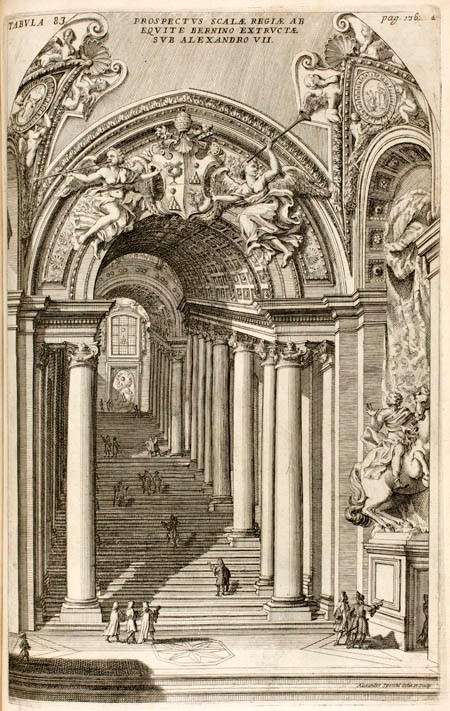After Paul V’s papacy the Vatican Palace gradually began to lose its importance as a reference point for the latest developments in Italian art. Perceived as finished, the historic papal residence next to Saint Peter’s was rarely an object of personalized commissions on the part of seventeenth-century popes, who were intent instead on promoting either their own family palaces or the Quirinale. As various archival sources confirm, the Vatican Palace continued to be a basic item in the budget of the Papal States for decorative works, painting conservation and restoration, liturgical updating, and the construction of important environments, such as the armory and the mint (both dismantled later). However, the lack of important contemporary artistic undertakings under papal patronage in the Vatican complex has directed the attention of recent studies away from this phase of its history, and until now there has been no adequate critical in-depth analysis of what happened in the palace next to Saint Peter’s from the seventeenth century to the second half of the eighteenth century, when, redesigned as a museum space, it became again the center of new architectural and decorative interventions of great importance.
During my residency, I tried to shed light on the known uses of the palace in the baroque period. First, with regard to the pope and his court, I seek to understand whether there was a relationship between the papal ceremonials that took place within certain areas of the palace and the restoration or redecoration of those spaces in the seventeenth and early eighteenth centuries. Here, I had the opportunity to use the rich material conserved in the Italian Architectural Drawings Photograph Collection of the National Gallery of Art Library, where photographs of many maps (such as the so-called King’s Maps of the British Library) and drawings for many projects (under the patronage, for example, of Urban VIII Barberini or Alessandro VII Chigi and today preserved in the Vatican Library) allowed me to identify the functions of different areas of the palace, the distribution within its rooms and halls of the various departments of the papal court (and their contemporary modifications), and the interior routes followed by the pope and visiting diplomats or rulers. Moreover, photographs of numerous sketches of the Vatican building complex, made by artists from different countries who passed through Rome in the baroque period and now preserved in European archives and libraries, have been important visual resources while I was confirming, as systematically as possible, information in various seventeenth-and eighteenth-century literary sources available in the Gallery’s library. Of particular interest were the rare books, especially biographical sources, guides, and diaries or letters written by visitors to the papal residence.
To reconstruct the pre-museum use of the palace by artists, distinguished visitors, and travelers who were admitted to the Vatican, I compared texts in various languages (by Romans, Italian travelers from outside Rome, and visitors from other countries, including America, from the second part of the eighteenth century onward), representing different perspectives (by Catholic and Protestant authors and by men of letters or simply young nobles), and in various forms (books mostly based on other literary sources, autoptic descriptions written to be published, and private reports originally intended only for limited circulation). In the end, this investigation permitted me to establish, among other things, which areas of the palace were accessible to visitors and which were not; to determine the reasons for such exclusions (such as ceremonial or residential use); to understand the variation in tastes at the time; and finally to assess the influence of Vasari in the use and experience of the palace in the baroque period. Although it is well known that the centuries-old evolution of the papal residence offered, with its own historical and stylistic stratifications, an extraordinary visual support for Vasari’s Lives, it is still worth establishing to what degree, especially from the second half of the seventeenth century, choices in the palace took into consideration Vasari’s consecration of the Vatican as the most prestigious site of Italian Renaissance art. A related question is what role this literary tradition played in the transformation of the papal palace into a destination for young artists and into a place to be preserved and never changed, as the topographic rereading of Vasari in eighteenth-century monographic guides to the Vatican complex seems to suggest.
Members' Research Report Archive
Literary Description and Visual Experience of the Vatican Palace In the Seventeenth and Eighteenth Centuries
Lucia Simonato, Scuola Normale Superiore di Pisa
Paul Mellon Visiting Senior Fellow / Millon Architectural History Guest Scholar, November 4–December 31, 2013

Alessandro Specchi, Scala Regia, plate 83 from Filippo Buonanni, Numismata summorum Pontificum Templi Vaticani fabricam indicantia, chronologica eiusdem fabricae narratione ac multiplici eruditione explicata (Rome, 1715). National Gallery of Art Library, David K. E. Bruce Fund
- Specchi, Alessandro
- Italian, 1668 - 1729